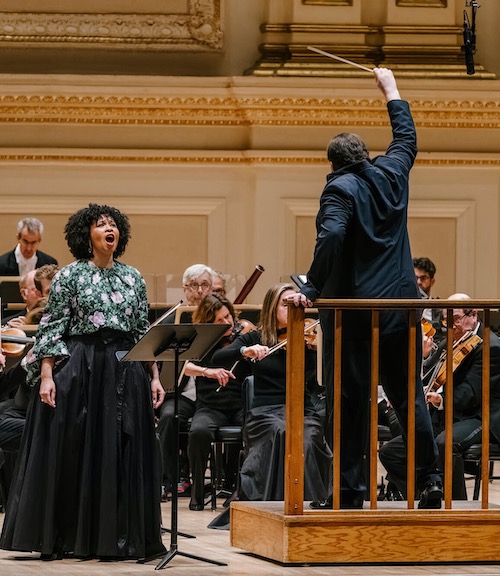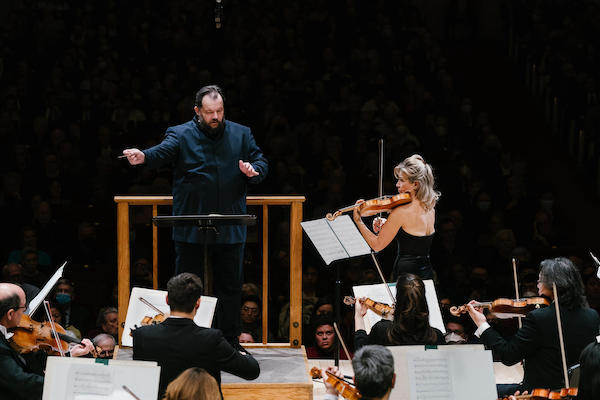Boston Symphony, soloists illuminate a Sibelius-centered program

The second of the Boston Symphony Orchestra’s two nights at Carnegie Hall had two features: the music of Jean Sibelius and the playing of violinist Anne-Sophie Mutter. Those two names in the same venue usually means Mutter is playing the composer’s Violin Concerto. But Tuesday night, that wasn’t the case.
With music director Andris Nelsons conducting, the concert opened with Sibelius’s tone poem Luonnotar, followed by Mutter in Mozart’s Violin Concerto No. 1 .The violinist returned after intermission as the solo voice in Thomas Adès’ Air (Homage to Sibelius), the proceedings then capped with the Sibelius Symphony No. 5.
This emphasis on the Finnish composer was the central pleasure of the concert. The BSO has been a great Sibelius orchestra since the Serge Koussevitzky era, in no small part due to its rich sound: the string grain, dark colors with pinpoints of light, the extremely rounded horns, and the overall ability to play with great beauty and expression whether the sound was small and focused or enormous. Few orchestras can sound as big as this one and tuttis were overwhelming, bringing out the great textures and atmospheres in the composer’s music. Hearing the gleam of Golda Schultz’s voice against the quiet, feathery strings in Luonnotar began this compelling sonic experience.

The soprano was impressive in this subtly challenging part. The accompaniment is spare, the voice does almost all the work, but unlike an opera aria the sound and style are otherworldly—it’s a creation myth sung by the creator themselves. Schultz was technically fine, floating atop the orchestra and in command the whole way. This was more, a real performance with a dramatic sense of characterization beyond the notes on the page. Using small but specific inflection in rhythm and phrasing, at times staying slightly behind the pulse, Schulz brought this into monodrama.
The Mozart concerto was solid and also an odd experience, well played all the way through but, with Mutter, it was like seeing a great athlete playing at half speed. This is not to denigrate any of Mozart’s charm, but to point out that for an exceptional artist like Mutter, playing the music with smooth and precise tempos and articulation is the least of it. That’s what she did, from a full bottom register to a glistening high one.
She also played cadenzas by the romantic era violinist and composer Hans Sitt, an exceedingly odd choice as they are both anodyne and lugubrious, do nothing in particular with the bow and fingers, and in no way advance the music.
Yet in the middle was the Adagio movement, and it was in this slow, simple music where one heard Mutter’s great artistry. She does what few others even try, which is to change her sound while playing, not just picking and choosing moments for vibrato but move through a range of colors and timbres that is unequalled. In her hands, a single sustained note has a depth and complexity of meaning that goes beyond pleasure and gets to the very point of the music’s existence. This movement, modest in scope, was spellbinding.
The concert marked the New York premiere of Adès’ recent work, co-commissioned by Carnegie, and it proved memorable. One has not before heard Adès be so plainspoken, simple, and nondidactic. Air is all gentle, shimmery rising and falling patterns, the soloist playing short, climbing phrases, the orchestra spinning out descending scales, each rotating against the other like water wheels going in different directions. Mutter was again superb in subtle ways in this lovely music, playing almost without pause through nearly the entire work, with an easy focus and effortlessly expressing what seemed the expressive limits of the piece.
The performance of Sibelius’s Fifth Symphony was on the same level. The BSO can probably get out of bed and ably rip through this without a first cup of coffee; all the parts and ensembles, the solo voicings, were excellent. There was a beautiful obsidian sound from the clarinets, and tremendous force from the horn section.
Yet what made this so outstanding was Nelsons’ shaping of the symphony. This is the key, as the Fifth is sub rosa avant-garde, less a sequence of structured harmonies and melodies than a massive, complex presence that gradually shapes itself into the specific features of the finale, the three-note rising and falling horns and the last cadence. Tuesday night, this all came together with a clear large-scale plan, the drifting slabs of the first movement inexorably growing in space, the gentle flow of the Andante. One has rarely felt the connection between the opening fanfares and the last chord so completely.
The Helsinki Philharmonic Orchestra plays Sibelius and Saariaho 8 p.m. May 9. carnegiehall.org







